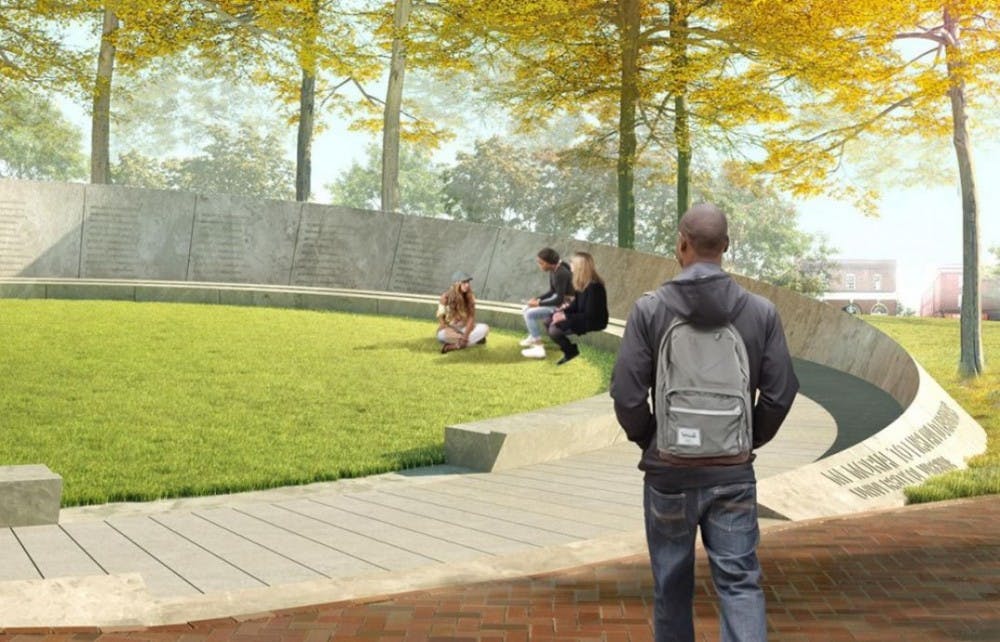Construction on the Memorial to Enslaved Laborers — a physical commemoration of the slave labor used to build much of the Academical Village — is underway on the triangle of grass east of the Rotunda and Brooks Hall and adjacent to University Avenue. It is expected to be fully completed in early October 2019.
Kirt von Daacke, assistant dean, history professor and co-chair of the President’s Commission on Slavery and the University, noted the significance of this particular location during an interview with The Cavalier Daily, saying that the triangle of grass was an accessible point of connection between the University and Charlottesville communities.
The Commission was established by former University president Teresa Sullivan to lead efforts to reconcile the University’s history of slave labor with the present day. It has two co-chairs, von Daacke along with Dr. Marcus Martin, vice president and chief officer for diversity and equity, and an additional 18 members from the University community, including professors, alumni and a representative from Monticello. The Commission has been tasked with research efforts, collaborating with peer institutions to discuss the history of slavery and college campuses and the memorial project.
Von Daacke also said that collaboration between the Commission and the community was crucial in selecting the memorial’s location. The Commission has actively sought community input on the memorial since work on the project began in 2011.
“When the Commission first started this process, we imagined it might be in a different place,” von Daacke said. “We didn’t have a location chosen. But through that conversation with the community, it moved to the Triangle of Grass because that is a gesture to the community, it’s visible from the community, it’s accessible from off-Grounds — it’s not hidden inside the Academical Village.”
Von Daacke also spoke about the involved process of conceptualizing a memorial capable of confronting the University’s grievances against enslaved laborers.
“‘Consider appropriate memorialization’ was the charge,” von Daacke said. “And as the Commission engaged in five years of contact with the community this was really listening, trust building and then asking for the community to help us shape what we were doing, to not only acknowledge, but to begin an atonement process for this history of slavery.”
The granite structure will form two concentric circles with an opening to create space for gathering and reflection. The inner walls of the memorial will feature 973 known names of individuals who were enslaved at the University, along with an estimated 4,000 placeholders for those whose names have not been discovered.
Two paths — one existing and one new — will lie tangent to the site and give its location additional symbolic meaning. The new path will be designed and constructed to point toward the North Star, which the enslaved followed to freedom. The other walkway already runs through the triangle of grass and parallels the path of the sun on March 3 — a date recognized as Liberation and Freedom Day in Charlottesville.
Von Daacke explained the importance of March 3, 1865, which holds historical prominence in the city as the day Union forces occupied Charlottesville — signifying the impending end of the Civil War and liberation of slaves.
“Nearly a thousand enslaved people left town after the three-day occupation, following the Union army out of town, and within a few months the University began paying former enslaved people to work at the University while the actual emancipation process was being worked out,” von Daacke said.
For the past two years, Charlottesville residents have honored the date with a march that begins on Grounds and goes down West Main Street. von Daacke noted that the Memorial to Enslaved Laborers will be incorporated as a stop on that march in future years. Past marches have included stops at Court Square and the Jefferson School in downtown Charlottesville
In August, the Board of Visitors approved funding for the project and endorsed University President Jim Ryan’s proposal that $2.5 million be allocated from the Strategic Investment Fund in order to one-to-one match private donor gifts to the memorial construction fund through 2019.
The current general contracting work on the site is tasked to Team Henry Enterprises, a construction company based in Newport News. Sarita Herman, the senior historic preservation manager for Facilities Management, said in a written statement to The Cavalier Daily that construction and landscaping will be complete in the fall, with pedestrian traffic being largely diverted from the site until then by a barrier.
“Construction completion is expected in early October 2019, with final plantings in November 2019,” Herman said. “The diagonal path from the University Avenue and Elliewood intersection to Hotel B/Washington Hall will remain closed for the full duration of construction. We will maintain at least one open pedestrian path from the University Avenue and Elliewood intersection to eastern end of the Long Walk throughout construction.”
According to Herman, recent snowfall has not impacted construction costs or the time frame due to accomodations made early on for possible inclement weather.
“Weather has the potential to impact the schedule, but not the cost of the project,” Herman said. “Some float is built into the schedule for weather impacts. It has not been detrimental to the long-term schedule thus far.”
Team Henry Enterprises will also install the large granite blocks foundational to the memorial’s shape and design, which was configured by a team led by the University’s Office of the Architect and the Boston based Höweler + Yoon architectural firm.
Updates on the project can be found on the design team’s Instagram and an upcoming live webcam feed of construction, which will be active in several weeks, according to University Communications.







